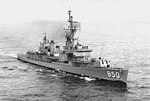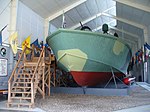Fall River Heritage State Park
1985 establishments in MassachusettsFall River, MassachusettsParks in Bristol County, MassachusettsProtected areas established in 1985State parks of Massachusetts ... and 2 more
Tourist attractions in Fall River, MassachusettsUse mdy dates from August 2023

Fall River Heritage State Park is a history-themed public recreation area on the Taunton River in Fall River, Massachusetts. The state park encompasses 14 acres (5.7 ha) beside the Charles M. Braga Jr. Memorial Bridge on Battleship Cove, home of the World War II battleship USS Massachusetts. The park is managed by the Massachusetts Department of Conservation and Recreation.
Excerpt from the Wikipedia article Fall River Heritage State Park (License: CC BY-SA 3.0, Authors, Images).Fall River Heritage State Park
Central Street, Fall River
Geographical coordinates (GPS) Address Nearby Places Show on map
Geographical coordinates (GPS)
| Latitude | Longitude |
|---|---|
| N 41.705555555556 ° | E -71.160555555556 ° |
Address
Central Street
02722 Fall River
Massachusetts, United States
Open on Google Maps











